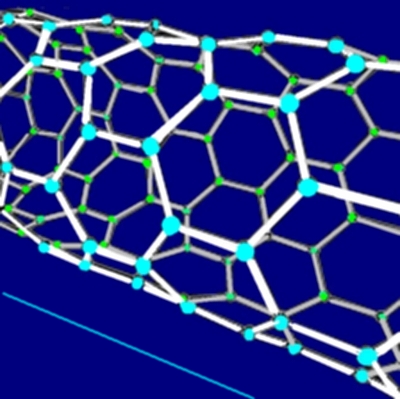BY LETTER
Fullerene
Science > Chemistry
Technology > Technology Type or Material > Drytech/Hylotech
Technology > Application > Materials Technology
Technology > Technology Levels > Middle Tech / Midtech
Technology > Technology Type or Material > Nanotech
Science > Chemistry > Organic Chemistry
Technology > Technology Type or Material > Drytech/Hylotech
Technology > Application > Materials Technology
Technology > Technology Levels > Middle Tech / Midtech
Technology > Technology Type or Material > Nanotech
Science > Chemistry > Organic Chemistry
 Image from Steve Bowers | |
| Carbon Nanotube, a form of highly elongated fullerene, with a much smaller magcarbon nanotube alongside for comparison. | |
Any molecule composed entirely of carbon, in the form of a hollow sphere, ellipsoid, or tube, as opposed to forms of carbon such as graphite or diamond which make extended networks that lead to crystals, or to amorphous forms of carbon such as soot. Spherical fullerenes are also known as buckyballs, and cylindrical fullerenes are known as carbon nanotubes or buckytubes.
Fullerenes were named after the early 1st century AT Old Earth thinker Buckminster Fuller, for the resemblance that a buckyball has to the geodesic domes he invented, since the carbon atoms form a series of hexagonal (sometimes pentagonal or heptagonal) rings. Since the Information Age, fullerenes have had a wide range of applications in materials science, electronics, and nanotechnology. The tensile strength of carbon nanotubes is an essential element in most megastructures, and fullerenes are a component in most varieties of diamondoid.
Related Articles
- Adamant
- Carbon
- Carbon Nanotube
- Diamondoid
- Fullerite - Text by M. Alan Kazlev
Atomically precise fullerene-like material, contains magmatter elements that greatly enhance performance. Widely used by some ISOs. - Pandifico: Elastic Diamondoid Fiber Composites
- Polyfullene - Text by Anders Sandberg
Polybuckminsterfullerene; nanofactured fullerene composite produced originally for Beanstalks but which also found many uses elsewhere. Polyfullene has a tensile strength close to the theoretical limits of molecular matter; a single one millimeter strand can easily support many tons. The most impressive property is that it is self-healing: if the nanotubes inside a Polyful filament are broken, fullerene from the matrix heals them only causing a slight lengthening.
Appears in Topics
Development Notes
Text by Stephen Inniss
Initially published on 05 June 2010.
Initially published on 05 June 2010.






